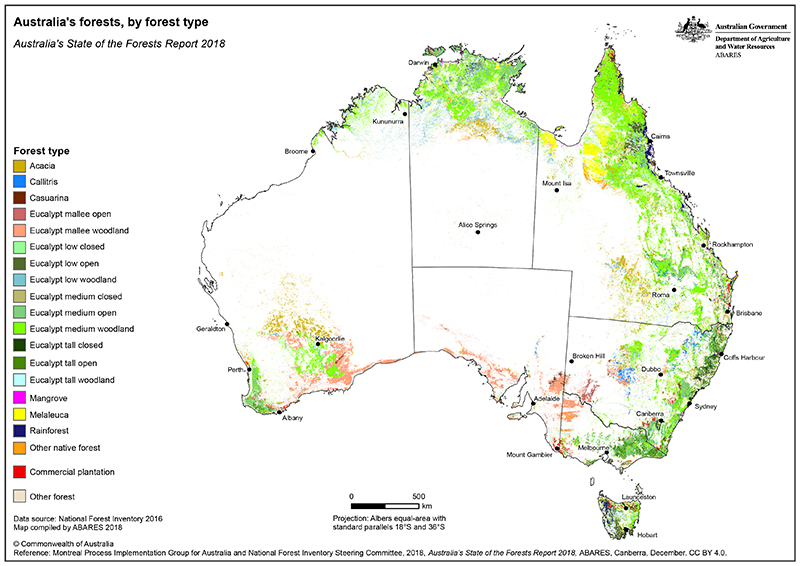The definition of forest used by Australia's National Forest Inventory is:
An area, incorporating all living and non-living components, that is dominated by trees having usually a single stem and a mature or potentially mature stand height exceeding 2 metres and with existing or potential crown cover of overstorey strata about equal to or greater than 20 per cent. This includes Australia’s diverse native forests and plantations, regardless of age. It is also sufficiently broad to encompass areas of trees that are sometimes described as woodlands.
Forest area

Australia has a total of 134 million hectares of forest, which is equivalent to 17per cent of Australia's land area. Of this total forest area, determined as at 2016, 132 million hectares (98 per cent) are 'Native forests', 1.95 million hectares are 'Commercial plantations' and 0.47 million hectares are 'Other forest'. Australia has about 3per cent of the world's forest area, and globally is the country with the seventh largest forest area.
Queensland has the largest area of Australia’s forest (51.8 million hectares—39 per cent of Australia’s forest), with the Northern Territory (23.7 million hectares—18 per cent), Western Australia (21.0 million hectares—16per cent), and New South Wales (20.4 million hectares—15 per cent), making up much of the balance.
Forest types and distribution
The forests of Australia are diverse and highly valued, and are among the country's most important natural resources.
Australia's native forests occur in a broad range of geographic landscapes and climatic environments, and contain a wide array of mostly endemic species (that is, species found nowhere else) combining to form unique and complex ecosystems. Australia's native forests provide a range of wood and non-wood products that are used by Australians in their everyday lives. They also provide clean water; protect soil; provide opportunities for recreation and tourism, and scientific and educational pursuits; and support cultural, heritage and aesthetic values.
Native forests are categorised in Australia's National Forest Inventory into eight national forest types named after their key genus or structural form: Acacia, Callitris, Casuarina, Eucalypt, Mangrove, Melaleuca, Rainforest, and Other native forest (which includes a range of minor native forest types that are named after their dominant genera, including Agonis, Atalaya, Banksia, Hakea, Grevillea, Heterodendron, Leptospermum, Lophostemon and Syncarpia). Across the wide range of rainfall and soil conditions that support forest, most of Australia's 'Native forest' category of forest is dominated by eucalypts (77 per cent) and acacias (8 per cent).
In addition to native forests, Australia's National Forest Inventory recognises two other categories of forest. 'Commercial plantations' are plantations grown on a commercial scale for wood production, while 'Other forest' includes small areas of mostly non-industrial plantations and planted forests of various types including sandalwood plantations, small farm forestry and agroforestry plantations, plantations within the reserve system, and plantations regarded as non-commercial. Non-planted forest dominated by introduced species is also included in the Other forest category.
Australia's Commercial plantations are a major source of commercial wood products. About half of Australia's Commercial plantations are exotic softwood (predominantly Pinus radiata), while the other half are hardwood (predominantly eucalypt species).
Forests are generally confined to regions where average rainfall exceeds 500 millimetres per year. Forests extend across Australia's northern tropical regions, and down the east coast through sub-tropical regions to temperate cool-season wet and cold–wet zones in the south-east; they are also found in Mediterranean climate zones in the south-east and south-west. In some regions, forests extend from these wetter, coastal and sub-coastal areas into central, drier parts of the continent. Through these regions, forests grow on soils that vary from ancient, fragile and infertile soils, to recent, fertile soils of volcanic origin.
Forest tenure and ownership
The ownership of a forest, especially native forest, has a major bearing on its management intent. The six tenure classes used for forests in the National Forest Inventory are amalgamations of the wide range of classes used by various state and territory jurisdictions. The classes can be grouped on the basis of ownership as public or private, with a small area of unresolved tenure. Publicly owned forests include ‘nature conservation reserve’, ‘multiple-use public forest’ and ‘other Crown land’. ‘Leasehold forest’ is forest on Crown land (land that belongs to a national, state or territory government) that is typically privately managed. Some forests on private land are publicly managed as conservation reserves. For industrial plantations, the ownership of the land can be different from the ownership of the trees, and management arrangements can be complex.
Of the 132 million hectares of native forest in Australia, 47.2 million hectares (36per cent) are native forest on leasehold land, and 41.0 million hectares (31per cent) are native forest on land held under private freehold title. Consequently, a total of 88.2 million hectares (67 per cent) of Australia’s native forest is under some form of private management. A further 21.7 million hectares of native forest (17per cent) are in formal nature conservation reserves, and 9.8 million hectares of native forest (7.4per cent) are in multiple-use public native forests.
About one-third of Australia’s forests (69.5 million hectares, 52 per cent of Australia's forest area) is identified as part of the Indigenous forest estate as one of four broad Indigenous land tenure and management categories: Indigenous owned and managed; Indigenous managed; Indigenous co-managed; and Other special rights. About 69 per cent of this forest area is in Queensland and the Northern Territory.
Forests Australia website
The Forests Australia website provides up-to-date information on Australia's forests including forest-related publications and maps, and links to forest management organisations and institutions.
The website represents collaboration between many Australian forest-related organisations, including all Australian, state and territory governments.
Naming conventions for forest names
The names of the national native forest types have capitalised initial letters (e.g. Acacia forest). The related common names do not have capitalised initial letters (e.g. acacias). The related formal genus names are italicised and have capitalised initial letters (e.g. Acacia).
